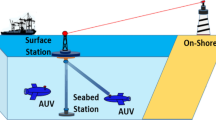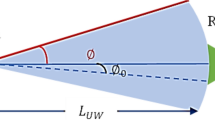Abstract
Oceans and deep seas have always been a root of great paradox to mankind. The oceans, covering greater than 75% of the Earth surface, are unexplored and implausible to investigate because of diverse phenomena practices in the underwater medium. Under water communication plays a significant role in observation of water pollution, natural disaster surveillance, coastal securities naval tactical activities, marine life and to investigate the variations in the underwater environment. However, under water channel is ambiguous in nature and causes low bandwidth, security issue, low transmission range and cost limitations because of interaction with the water channel. In this regards, a high speed hybrid passive optical network (PON) and visible light communication (VLC) using red-green-blue light emitting diodes system for land-to-underwater applications has been proposed and investigated for the data transmission over a hybrid fiber-wireless link under different water types. Time and wavelength division multiplexing wavelength division multiplexing PON employing different optical code division multiple access codes offering data security to different under ocean connected devices with minimum energy consumption, is analysed. The results shows that shift zero cross-correlation code offers a faithful 100 km fiber length and 5 m VLC range at high data rate of 10 Gbps having 76 dB optical signal to noise ratio for 200 undersea devices in both downstream and upstream transmission. Moreover, undersea VLC range can be improved up to 10 m with blue LED. The mathematical analysis and comparative performance reveal the superiority of proposed system than existing literature.









Similar content being viewed by others
References
Spagnolo, G. S., Cozzella, L., & Leccese, F. (2020). Underwater optical wireless communications: overview. Sensors, 20(8), 2261.
Gill, H. S., & Singh, M. L. (2021). Performance evaluation of DVB-t image transmission over a MIMO OWC channel at 650 nm under varying turbulence regimes. Wireless Networks, 27(3), 1965–1979. https://doi.org/10.1007/s11276-021-02559-5
Becvar, Z., Cheng, R. G., Charvat, M., & Mach, P. (2020). Mobility management for D2D communication combining radio frequency and visible light communications bands. Wireless Networks, 26(7), 5473–5484. https://doi.org/10.1007/s11276-020-02408-x
Irawan, A., Abas, M. F., & Hasan, N. (2019). Robot local network using TQS protocol for land-to-underwater communications. Journal of Telecommunications and Information Technology, 1(2019), 23–30. https://doi.org/10.26636/jtit.2019.125818
Abdulwahhab, A. W. (2022). Power consumption management in hybrid optical–Wireless access network. Optical Fiber Technology, 70, 102882. https://doi.org/10.1016/j.yofte.2022.102882
Shao, Q., Zhao, Y., Chen, Y., & Gan, C. (2019). High-reliability grid architecture supporting discretionary and efficient communication between ONUs in metro-access optical network. International Journal of Communication Systems, 32(14), e4086. https://doi.org/10.1002/dac.4086
Ali, A., Ali, K., & Shaikh, A. A. (2014). Energy and delay aware routing algorithm for fiber-wireless networks. Wireless Networks, 20(6), 1313–1320. https://doi.org/10.1007/s11276-013-0679-5
Kumari, M., Sharma, R., & Sheetal, A. (2020). Performance analysis of high speed backward compatible TWDM-PON with hybrid WDM–OCDMA PON using different OCDMA codes. Optical and Quantum Electronics. https://doi.org/10.1007/s11082-020-02597-x
Butt, R. A., Idrus, S. M., Zulkifli, N., & Waqar Ashraf, M. (2018). Comprehensive bandwidth utilization and polling mechanism for XGPON. International Journal of Communication Systems, 31(3), e3475. https://doi.org/10.1002/dac.3475
Morsy, M. A., & Alsayyari, A. S. (2020). Performance analysis of coherent BPSK-OCDMA wireless communication system. Wireless Networks, 26(6), 4491–4505. https://doi.org/10.1007/s11276-020-02355-7
Vijayakumari, P., & Sumathi, M. (2019). Physical implementation of underwater optical wireless system using spatial mode laser sources with optimization of spatial matching components. Results in Physics, 14, 102503. https://doi.org/10.1016/j.rinp.2019.102503
Liu, Y., Xu, H., Shang, D., Li, C., & Quan, X. (2019). An underwater image enhancement method for different illumination conditions based on color tone correction and fusion-based descattering. Sensors, 19(24), 5567. https://doi.org/10.3390/s19245567
Jasman, F., & Green, R. J. (2013). Monte Carlo simulation for underwater optical wireless communications. Proceedings of the 2013 2nd International Workshop on Optical Wireless Communications, IWOW 2013, 113–117. https://doi.org/10.1109/IWOW.2013.6777789.
Cox, W., & Muth, J. (2014). Simulating channel losses in an underwater optical communication system. Journal of the Optical Society of America A, 31(5), 920. https://doi.org/10.1364/josaa.31.000920
Huang, A., Tao, L., & Jiang, Q. L. (2018). BER performance of underwater optical wireless MIMO communications with spatial modulation under weak turbulence. In 2018 OCEANS-MTS/IEEE Kobe Techno-Oceans, OCEANS-Kobe 2018 (pp. 1–5). https://doi.org/10.1109/OCEANSKOBE.2018.8559096
Campagnaro, F., Signori, A., & Zorzi, M. (2020). Wireless remote control for underwater vehicles. Journal of Marine Science and Engineering, 8(10), 1–32. https://doi.org/10.3390/JMSE8100736
Doniec, M., Angermann, M., & Rus, D. (2013). An end-to-end signal strength model for underwater optical communications. IEEE Journal of Oceanic Engineering, 38(4), 743–757. https://doi.org/10.1109/JOE.2013.2278932
Arnon, S., & Kedar, D. (2009). Non-line-of-sight underwater optical wireless communication network. Journal of the Optical Society of America A, 26(3), 530. https://doi.org/10.1364/josaa.26.000530
Lu, I. C., & Liu, Y. L. (2018). 205 Mb/s LED-based underwater optical communication employing OFDM modulation. In 2018 OCEANS-MTS/IEEE Kobe Techno-Oceans, OCEANS - Kobe 2018 (Vol. 1, pp. 1–4). IEEE. https://doi.org/10.1109/OCEANSKOBE.2018.8559430.
Liu, X., Yi, S., Liu, R., Zheng, L., & Tian, P. (2017). 34.5 m Underwater optical wireless communication with 2.70 Gbps data rate based on a green laser with NRZ-OOK modulation. In 2017 14th China International Forum on Solid State Lighting: International Forum on Wide Bandgap Semiconductors China, SSLChina: IFWS 2017 (pp. 60–61). https://doi.org/10.1109/IFWS.2017.8245975.
Wang, J., Lu, C., Li, S., & Xu, Z. (2019). 100 m/500 Mbps underwater optical wireless communication using an NRZ-OOK modulated 520 nm laser diode. Optics Express, 27(9), 12171. https://doi.org/10.1364/oe.27.012171
Liu, W., Xu, Z., & Yang, L. (2015). SIMO detection schemes for underwater optical wireless communication under turbulence. Photonics Research, 3(3), 48. https://doi.org/10.1364/prj.3.000048
Katz, M., & O’Brien, D. (2019). Exploiting novel concepts for visible light communications: From light-based IoT to living surfaces. Optik, 195, 163176. https://doi.org/10.1016/j.ijleo.2019.163176
Furqan Ali, M., Nalin Jayakody, D. K., Ponnimbaduge Perera, T. D., Srinivasan, K., Sharma, A., & Krikidis, I. (2019). Underwater Communications: Recent Advances. In International Conference on Emerging Technologies of Information and Communications (ETIC).
Luo, J., Fan, L., & Li, H. (2017). Indoor positioning systems based on visible light communication: state of the art. IEEE Communications Surveys and Tutorials, 19(4), 2871–2893. https://doi.org/10.1109/COMST.2017.2743228
Kachhatiya, V., & Prince, S. (2016). Four-fold increase in users of time-wavelength division multiplexing (TWDM) passive optical network (PON) by delayed optical amplitude modulation (AM) upstream. Optical Fiber Technology, 32, 71–81.
Mostafa, S., & Mohamed, A. E. A. (2017). Performance evaluation of SAC-OCDMA system in free space optics and optical fiber system based on different types of codes. Wireless Personal Communications, 96(2), 2843–2861. https://doi.org/10.1007/s11277-017-4327-8
Rashidia, C. B. M., Aljunid, S. A., Ghani, F., Fadhil, H. A., & Anuar, M. S. (2013). New design of flexible cross correlation (FCC) Code for SAC-OCDMA system. Procedia Engineering, 53, 420–427. https://doi.org/10.1016/j.proeng.2013.02.055
Wei, Z., Shalaby, H. M. H., & Ghafouri-Shiraz, H. (2001). Modified quadratic congruence codes for fiber Bragg-grating-based spectral-amplitude-coding optical CDMA systems. Journal of Lightwave Technology, 19(9), 1274–1281.
Cao, Y., & Gan, C. (2012). A scalable hybrid WDM/OCDMA-PON based on wavelength-locked RSOA technology. Optik, 123(2), 176–180. https://doi.org/10.1016/j.ijleo.2011.03.015
Gan, C. Q., & Cao, Y. N. (2011). Novel architecture of WDM/OCDMA-PON based on SSFBG and wavelength re-modulation technology. Journal of Shanghai University, 15(2), 96–100. https://doi.org/10.1007/s11741-011-0700-3
Kumari, M., Sharma, R., & Sheetal, A. (2021). A hybrid next-generation passive optical network and visible light communication for future hospital applications. Optik, 242, 166978. https://doi.org/10.1016/j.ijleo.2021.166978
Arnon, S. (2010). Underwater optical wireless communication network. Optical Engineering, 49(1), 015001. https://doi.org/10.1117/1.3280288
Spagnolo, G. S., Cozzella, L., & Leccese, F. (2020). A Brief Survey on Underwater Optical Wireless Communications. In MetroSea 2020 - TC19 International Workshop on Metrology for the Sea (pp. 79–84).
Moench, W., & Loecklin, E. (2017). Measurement of Optical Signal to Noise Ratio in Coherent Systems using Polarization Multiplexed Transmission. In Optical Fiber Communication Conference (pp. 1–4).
Abd, T. H., Aljunid, S. A., & Fadhil, H. A. (2011). A new technique for reduction the phase induced intensity noise in SAC-OCDMA systems. Journal of Optical Communications, 32(4), 263–267.
El-Mottaleb, S. A. A., Fayed, H. A., Ismail, N. E., Aly, M. H., & Rizk, M. R. M. (2020). MDW and EDW/DDW codes with AND subtraction/single photodiode detection for high performance hybrid SAC-OCDMA/OFDM system. Optical and Quantum Electronics. https://doi.org/10.1007/s11082-020-02357-x
Samanta, S., Maity, G. K., & Mukhopadhyay, S. (2019). All-optical Walsh-Hadamard code Generation using. In 2019 Devices for Integrated Circuit (DevIC) (pp. 515–518).
Kumawat, S., & Ravi Kumar, M. (2016). Generalized optical code construction for enhanced and modified double weight like codes without mapping for SAC-OCDMA systems. Optical Fiber Technology, 30, 72–80. https://doi.org/10.1016/j.yofte.2016.03.004
Cantono, M., Mecozzi, A., Curri, V., & Gaudino, R. (2015). Optimal polarization launch for Raman depletion minimization in GPON and TWDM-PON coexistence. In Optical Fiber Communication Conference, OFC 2015.
Mandal, G. C., Mukherjee, R., Das, B., & Patra, A. S. (2018). A full-duplex WDM hybrid fiber-wired/fiber-wireless/fiber-VLC/fiber-IVLC transmission system based on a self-injection locked quantum dash laser and a RSOA. Optics Communications, 427, 202–208. https://doi.org/10.1016/j.optcom.2018.06.048
Cheng, N. (2015). Flexible TWDM PON with WDM overlay for converged services. Optical Fiber Technology, 26, 21–30.
He, J., Dong, H., Deng, R., Shi, J., & Chen, L. (2016). WDM-CAP-PON integration with VLLC system based on optical frequency comb. Optics Communications, 374, 127–132. https://doi.org/10.1016/j.optcom.2016.04.059
De Moura, U. C., Oliveira, J. R. F., Oliveira, J. C. R. F., & Cesar, A. C. (2013). EDFA adaptive gain control effect analysis over an amplifier cascade in a DWDM optical system. In SBMO/IEEE MTT-S International Microwave and Optoelectronics Conference Proceedings https://doi.org/10.1109/IMOC.2013.6646469.
Lavrinovica, I., & Porins, J. (2015). Noise Figure Analysis of EDFA with different pumping configurations in 40 Gbit/s 8 channel DWDM transmission system. In Proceedings - 2015 Advances in Wireless and Optical Communications, RTUWO 2015.
Acknowledgements
The author is thankful to Chandigarh University, Mohali, India for providing opportunity to complete the work as effective.
Funding
No funds, grants, or other support was received.
Author information
Authors and Affiliations
Contributions
The author contributed to the study conception and design.
Corresponding author
Ethics declarations
Conflict of interest
The author declares that they have no conflict of interest.
Additional information
Publisher's Note
Springer Nature remains neutral with regard to jurisdictional claims in published maps and institutional affiliations.
Rights and permissions
Springer Nature or its licensor (e.g. a society or other partner) holds exclusive rights to this article under a publishing agreement with the author(s) or other rightsholder(s); author self-archiving of the accepted manuscript version of this article is solely governed by the terms of such publishing agreement and applicable law.
About this article
Cite this article
Kumari, M. Performance analysis of high speed hybrid PON-VLC for long-reach land-to-underwater applications. Wireless Netw 29, 1721–1735 (2023). https://doi.org/10.1007/s11276-022-03223-2
Accepted:
Published:
Issue Date:
DOI: https://doi.org/10.1007/s11276-022-03223-2




